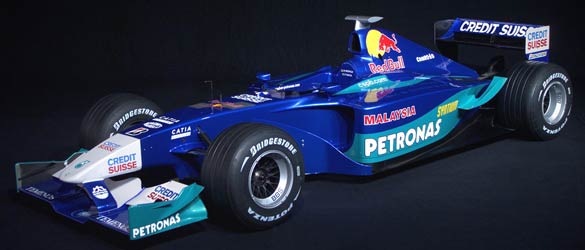Team Milestones
32 Years of Sauber Motorsport
The small town of Hinwil in the Zurich Highlands is probably not, at first sight, the place you would expect to find a highly developed Formula One centre equipped to the finest technical detail. Only a few steps from where Peter Sauber started out in 1970 as an independent businessman, the high tech race cars have been built for the Formula One World Championships since 1993.
The development of high technology within the field of motor racing has always fascinated Peter Sauber. While some of today's competitors were already active in the supreme class of motorsport, Peter Sauber started his race car constructor's career with sporting variations of the legendary Volkswagen Beetle.
C for Christiane
Soon after, Peter Sauber moved from Beetle tuning to building two-seater open sportscars. The beginning of a long series was the C1 which was designed in the basement of his parents apartment. For the car's name, the constructor chose the first initial of his wife's name Christiane, a tribute to the patience with which she has accepted her husband's frequent absences from home. Until this day all Sauber constructions carry the initial C in their names. The latest model is the C19, the race car for 2000. The only missing number was the C10 (simply because of the German pronunciation), and the only exception to the rule was a car with the C291 specification.
In the beginning, the boss raced the cars himself. Although Peter Sauber's ambitions were in the constructor's field, he managed to win the Swiss Driversí Championship. But soon he switched from holding the wheel to the constructorís desk, and just as soon the designer's reputation was also to be known outside Switzerland.
Mercedesí Spearhead
The first major success of the Hinwil technology plant came towards the end of the eighties. From 1988, Sauber was the spearhead for the return of Mercedes to motorsport. Highlights of this partnership with the renowned manufacturer from Stuttgart include a double win at Le Mans (1989) and both the Constructorsí and Driversí World Championships (1989 and 1990). Among the drivers making history at Sauber in 1990 and 1991 were three young men forming a great junior team: Michael Schumacher, Heinz-Harald Frentzen and Karl Wendlinger.
Peter Sauber took the plunge alone into Formula One in 1993, albeit under close observation from Stuttgart. The partnership with Mercedes was revived for a brief period before Sauber became Ford's official works team for two years. The 84 World Championship points scored in 113 Grands Prix were contributed by the drivers JJ Lehto, Karl Wendlinger, Heinz-Harald Frentzen, Andrea De Cesaris, Jean-Christophe Boullion, Nicola Larini, Johnny Herbert, Jean Alesi and Pedro Diniz; Gianni Morbidelli and Norberto Fontana never managed to finish in the points.
Partnerships
Since 1997 Sauber has been structuring its own engine competence. Their entry into the fascinating world of high performance race engines has been made possible by a contract with Ferrari covering technical co-operation. Sauber Petronas Engineering AG, a joint-venture with partner Petronas founded in Spring 1996, is not only active in the construction and development of race engines but also markets technological Formula One competence commercially.
High Tech Development Centre
In Sauberís high tech factory with a total of 8000 square metres more than 200 specialists work almost exclusively for the F1 project. About another 50 employees work for suppliers in the vicinity, occupied solely with the production of F1 components for the Sauber race cars.
For the design and construction of the race cars, the team have highly modernised CAD systems and an infrastructure for the production of all mechanical parts as well as their own two autoclaves which produce most composite parts. In Summer 1999 a seven-post-rig was installed in a new separate building. The rig allows for the simulation of the car's reactions on any given race track.
Related Links
The 2002 Sauber Launch Pictures
The 2002 Sauber Launch News Report
The official Sauber web site
The official Nick Heidfeld web site
Sauber F1 Statistics on FORIX
![]()

![]()
